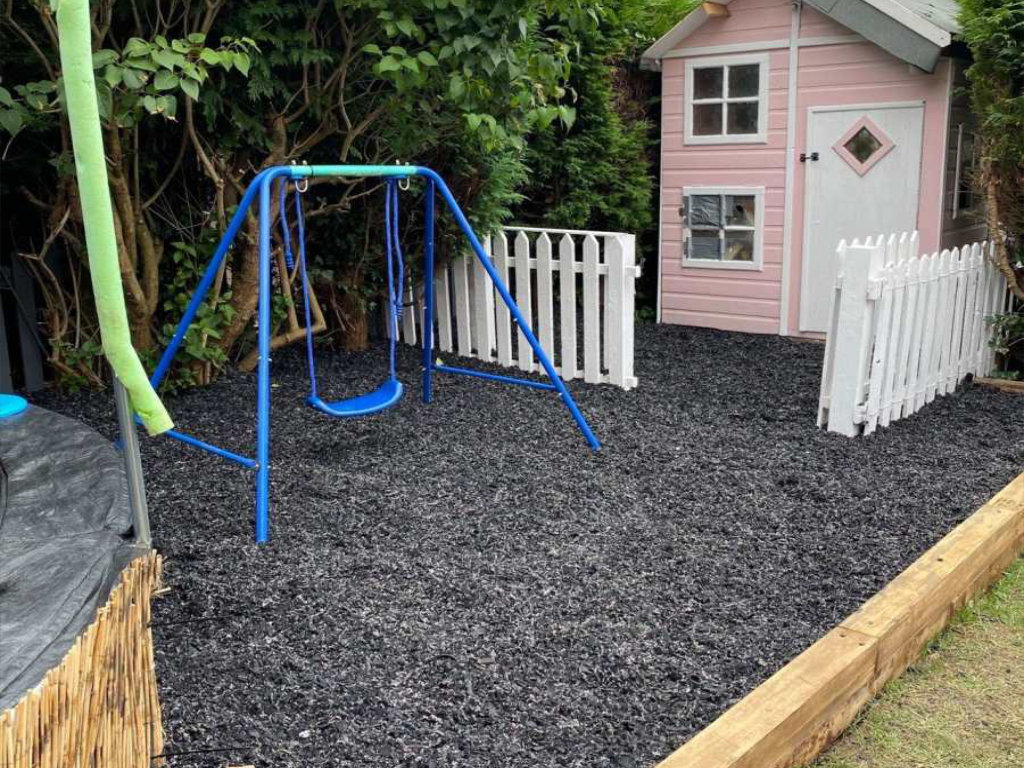Rubber chippings, also referred to as rubber mulch or rubber bark, are becoming an increasingly popular choice for landscaping, playgrounds, and equestrian surfaces. Made from recycled tires, rubber chippings are an environmentally friendly alternative to traditional mulch and offer a range of benefits, including reduced maintenance, improved safety, and increased durability. But before diving into your rubber chipping project, you need to work out how much rubber chippings you’ll need. In this blog post we’ll explore how to calculate rubber mulch, what to put under it, how deep it should be, and much more.
Accurately calculating your chipping coverage quantities
The first step in calculating how much rubber mulch you’ll need to buy is to calculate the area you need to cover. To do this, measure the length and width of the area in feet, and multiply the two numbers together. For example, if you have a playground that measures 20 feet by 30 feet, you would need to cover 600 square feet.
Once you have the square footage, you can calculate how much rubber mulch you need in cubic feet. The rule of thumb, is that you need 1.5 pounds of rubber mulch per square foot, for a depth of 1 inch. To convert this into cubic feet, divide the total weight by the weight per cubic foot of rubber mulch, which is typically around 40 pounds. So, for our example playground, if we wanted to cover it with 2 inches of rubber mulch, we would need 1,800 pounds (or 45 cubic feet) of rubber mulch.

What do you put under rubber chippings?
While rubber chippings are a great choice for various applications, it’s important to remember that they are not a substitute for proper surface preparation. For playgrounds and other high-impact areas, we’d always recommended that you install a geotextile fabric layer. This will prevent weeds from growing up through the rubber, and to provide a stable base for the material.
In addition to geotextile fabric, you may also want to consider adding a layer of crushed stone or gravel to the base of your rubber mulch. This will help with drainage, and prevent the material from sinking over time. It’s also important to note that rubber mulch should never be installed on top of soil or grass, as this can lead to problems with mould, mildew, and insect infestations.
Are rubber chippings better than play bark?
While rubber chippings and play bark are popular playground choices, the two materials have some key differences. Rubber chippings are often considered a more durable and low-maintenance option, as they don’t break down over time and don’t require regular topping up like play bark. Rubber chippings also offer superior impact protection, making them safer for high-impact areas like swings and climbing frames.
However, play bark has its advantages. It’s often less expensive than rubber chippings and provides a more natural look that some people prefer. Play bark is also more biodegradable than rubber mulch and can help improve soil quality over time.
Ultimately, the choice between rubber chippings and play bark will depend on your specific needs and preferences.
How deep should rubber mulch be?
The depth of your rubber mulch will depend on the application. For playgrounds and other high-impact areas, we recommended that you use a depth of at least 6 inches to provide adequate impact protection. A depth of 2-3 inches is typically sufficient for landscaping and other decorative applications.
It’s also important to note that the depth of your rubber mulch will affect how much material you need. As we mentioned earlier, you’ll need approximately 1.5 pounds of rubber mulch per square foot for a depth of 1 inch. So if you want to install 6 inches of rubber mulch on your playground, you’ll need 9 pounds of rubber mulch per square foot.

Advantages of rubber chippings
Rubber chippings, which are made from recycled rubber, have several advantages over other materials, such as gravel or wood chips. Here are some of the main advantages:
- Safety: Rubber chippings are much safer than other materials as they provide a soft, cushioned surface that reduces the risk of injury in case of falls. This makes them ideal for playgrounds, sports facilities, and other high-impact areas.
- Durability: Rubber chippings are very durable and long-lasting. They do not decompose or rot like wood chips, and they do not disintegrate like gravel. They also do not attract insects or pests.
- Low maintenance: Rubber chippings require very little maintenance compared to other materials. They do not need to be replaced as often and do not require regular raking or other upkeep.
- Environmentally friendly: Rubber chippings are made from recycled rubber, which reduces waste and promotes sustainability. They are also non-toxic and do not release harmful chemicals into the environment.
- Versatility: Rubber chippings can be used in various applications, including landscaping, playgrounds, and sports facilities. They come in various colours and sizes, making them a versatile and attractive option for many projects.
Overall, rubber chippings are a safe, durable, low-maintenance, environmentally friendly, and versatile option for many different applications. For more information on rubber chippings, check out our blog highlighting everything you need to know now! Or contact us today to find out more.
